Growing irises – the answers to your questions
I’ve been talking to iris specialists Iris of Sissinghurst about growing irises.
Sue Marshall owns and runs Iris of Sissinghurst and they only grow irises. They sell by mail order, to garden designers and for the shows, such as the RHS Chelsea Flower Show, where they have won several awards.
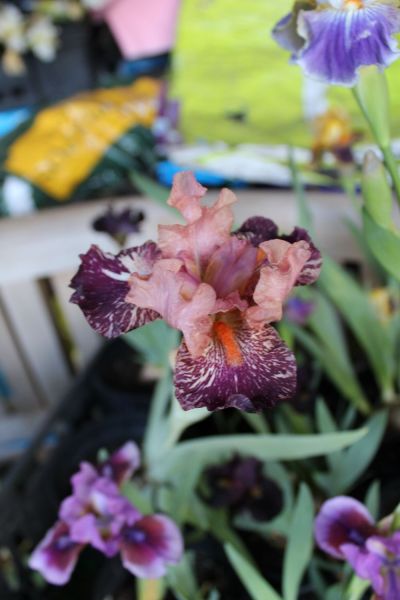
Irises from Iris of Sissinghurst, including (centre) ‘Anaconda Love.’ Photo by Sophie Leathart.
Sue says there’s an iris for every situation and every garden, whether small, middle-sized or large, regardless of your climate, soil or even if your garden is quite shady.
Irises are not just water plants
There is a typical misconception that irises are water plants. There are water irises, but they’re only a small selection of what you can grow.
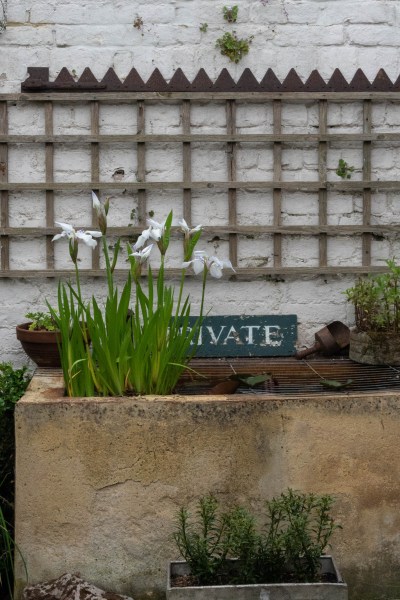
White water irises in a raised garden pond.
They’re typically Mediterranean plants so love hot, dry climates. Yet I garden on heavy clay soil in what would be a zone 8 or 9 in South east England, as do Iris of Sissinghurst. I have about 5 different bearded irises doing well, plus several very happy, prolific clumps of Siberian irises.
Irises come in the most stunning colours
You can get pretty pastels and whites or outrageously tropical oranges and pinks.
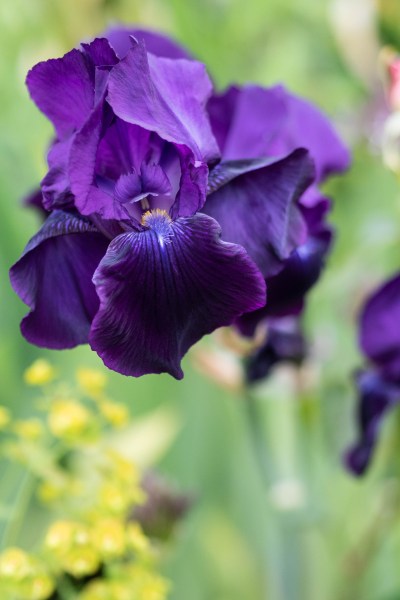
This is Iris ‘Sable’ which has thrived on neglect in my garden for about six years. I always thought growing irises would be difficult, but ‘Sable’ (and several others) have proved me wrong.
And then there are the beautifully classic blues and purples.
Most importantly, many newly-bred irises bloom for longer, and will put up with more shade than some of the traditional ones.
So there is real potential for irises to be to our spring and summer gardens what dahlias are to the autumn garden, whether you want a romantic soft look or a brilliantly colourful, exotic tropical look or anything in between.
And it’s also worth remembering that the spiky, sculptural iris leaves add structure to a border even when the plant is not in flower.
Irises are surprisingly easy to grow…
The American Iris Society, celebrating its centenary this year, says irises are amongst the easiest perennials to grow.
I would really echo that – I’d always thought that growing irises wasn’t for me. Seeing their frilly, fragile flowers, I thought they would need a lot of time and attention, but not a bit of it. I’ve had four irises for around seven years in this garden and they have been almost no work at all.

Iris ‘Folie Douce’ has also flowered reliably in my over-crowded border. And so beautiful!
There is iris care advice on both the Iris of Sissinghurst and the American Iris Society websites. And they were going to share a stand at the now-cancelled RHS Chelsea Flower Show 2020.
Can irises grow in shade? Or do they need sun?
Generally, irises do best in full sun says Sue.
Those of us with small and middle-sized gardens often have very little in the way of full sun – and lots of plants that need sun. But we can still grow a range of irises.
There are many kinds of iris, says Sue, but in this post, I’ll stick to the tall, intermediate, short bearded irises and Siberian irises because these are amongst the ones you’re most likely to buy for your garden.
Tall bearded irises – they’ll be 2-3ft tall – do need full sun advises Sue.
But the intermediate – about 18” high – or short irises – about 12”, as well as Sibirica irises can often manage borders where they’re in the sun for half a day and shaded the other half.
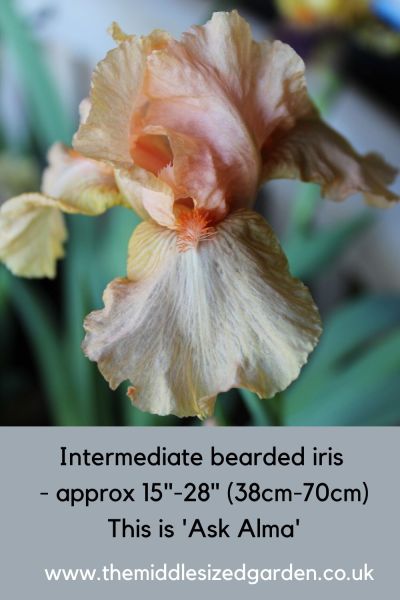
Short and intermediate irises can take half day shade/half day sun. This is ‘Ask Alma’ from Iris of Sissinghurst.
The thing to understand is that irises need the sun on their rhizomes, especially in summer, so if they’re surrounded by very leafy shrubs or flowers, make sure these leaves aren’t shading the rhizomes. It’s also worth knowing that sometimes an iris in a shadier spot will still flower, but it will flower less.
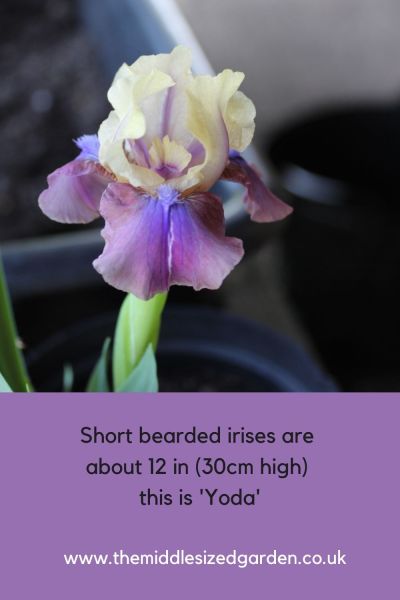
Short bearded iris from Iris of Sissinghurst – short bearded irises are also happy with some shade.
An iris for every situation…
At Doddington Place Gardens in Kent, there are some beautiful tall irises in an open sunny position over looking countryside.
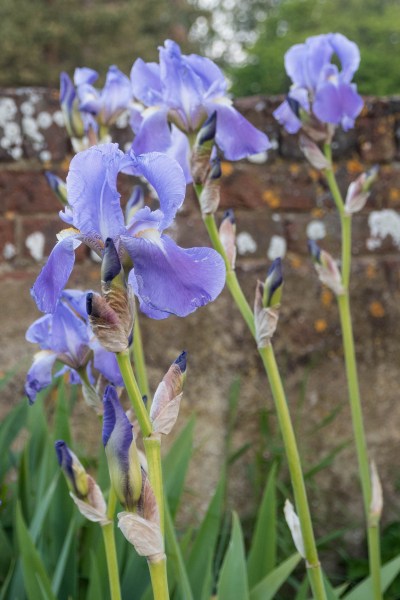
Tall bearded irises growing by a low wall in open sun at Doddington Place Gardens in Kent.
But just beside them is a large group of short irises growing under an old conifer. You wouldn’t normally think of growing a sun loving plant under the branches of a conifer, but there are reasons why this works.
Firstly, the conifer is tall and all the lower branches have been cut away. Quite a bit of sunlight reaches the irises. And secondly, these irises have been planted with plenty of space for light to reach their rhizomes.
You should plant iris rhizome so that the sun can bake it, says Sue. Under this conifer, there are no other plants alongside the irises to shade them with their leaves.
Plant irises in the fronts of borders…
You can maximise the sun to your iris by planting it in the front of a border. I’ve done this with several irises, including ‘Folie Douce’ and ‘Sable’. They have grown brilliantly although I do have tall trees and hedges in my garden, and quite packed borders.
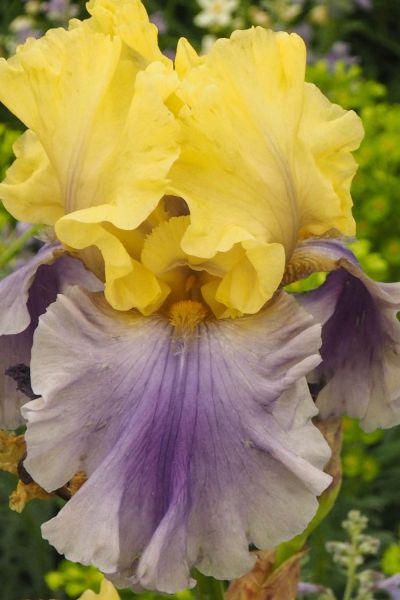
Show off your irises, like this magnificent Iris ‘Edith Wolford’, spotted at the front of a border in the Hilliers garden at the 2019 RHS Chelsea Flower Show.
Anything else about where to plant irises?
Sue says you can find a iris for any soil type, although they generally like well drained soil. It doesn’t have to be particularly fertile. Both Iris of Sissinghurst and I are on a Kent clay soil and the irises grow well on them.
But bearded irises won’t want to get too soggy, especially in winter. If you have a damp garden, check a specialist iris grower for irises that love damp soil.
When to plant irises?
Sue says you can plant pot grown irises, including iris sibirica, all year round but bare rooted irises should be planted from July to October. Plant sibirica irises in autumn.
More tips on choosing irises
Once you’ve assessed how much sun you can give your irises, then Sue says choose plant with good green leaves with no spots. Spots could indicate a fungal disease. And choose irises with a firm rhizome. You shouldn’t buy an iris that has any sign of a grey mould.
If the stem is already on the plant, count the buds. The more buds on an iris stalk, the longer it will flower as the buds open in succession. Newer varieties of iris have been bred for longer flowering times.
Older varieties tend to have fewer buds and consequently go over quicker.
You can often see a second bud behind the first one. Once the first flower is dying, snip it off to allow the bud behind to develop. In hot weather, the buds will open sooner but if there’s a cool spell, they’ll slow down, so you can have an iris in flower for more than a month.
When to divide irises?
If you’re growing irises in your garden, they’ll need dividing every three to five years. If you’re growing irises in pots, they will need dividing as soon as their roots touch the side of the pot, because that’s something they really hate.
Divide in July, after they’ve flowered. Dig them up, split off rhizomes and discard oldest piece. Sue says that irises are remarkably tough – you can even cut a rhizome in half and if it still has roots on it, it will still grow.
Re-plant firm, plump rhizomes immediately but if they feel soft and withered then they are generally too old so should be discarded. Also cut the leaves across by about half – this is to reduce wind rock while the new roots are re-establishing – but it’s only after re-planting that you need to do this. While iris leaves are green, they are feeding the plant.
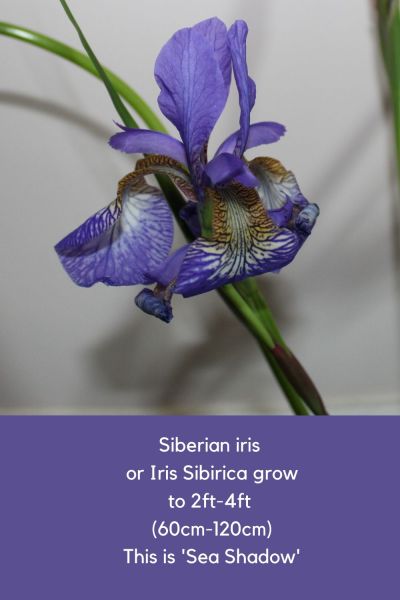
Treat Iris Sibirica as you would most perennial plants in your border.
You can lift and divide Iris Sibiricas in autumn, along with your other herbaceous perennials.
What plants go well with irises?
Iris of Sissinghurst recommends pairing alliums with irises, because allium foliage dies back early in summer and won’t shade the irises. Other bulbs such as nerines will grow happily beside irises, too, for the same reason.
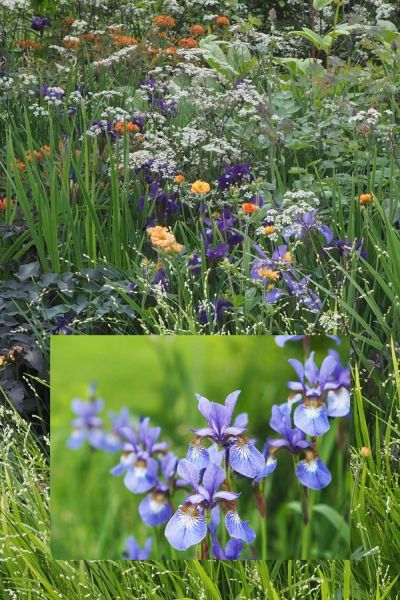
Iris Sibirica (Sibernian irises) seen in a herbaceous border in an RHS Chelsea Flower Show garden designed by Tom Stuart Smith
For a dramatic flower colour contrast, choose plants that flower at the same time, such as lupins, aquilegias and colombines, as do peonies. In my garden, a rose is happy side by side with an iris. But be careful that the peony or rose foliage doesn’t shade the iris rhizomes later on in the summer.
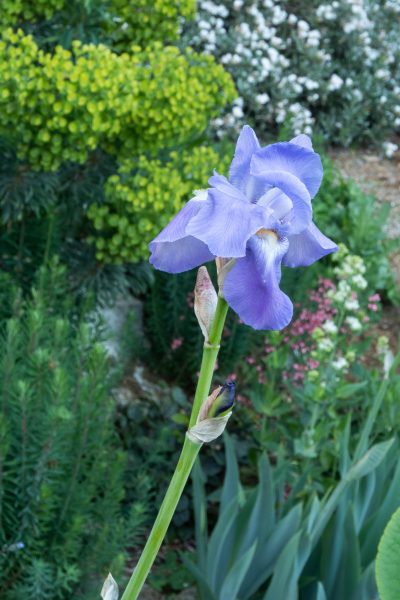
I love blue or purple irises against the citrussy green of euphorbia. Seen at Doddington Place Gardens
Personally I love seeing irises with euphorbia which is also good in late spring, early summer.
And Sue say says that the Sibirica irises will grow in a herbaceous border, partnering with most other perennials, so they don’t seem to mind a bit of crowding up.
Are there repeat flowering irises?
Yes – see Iris of Sissinghurst’s link to repeat flowering irises.
Irises that repeat flower include Tall bearded: Rosalie Figge, St Petersburg, Buckwheat, Autumn Circus, Mariposa Autumn, Best Bet, Champagne Elegance, Mariposa Skies in the tall bearded category. Short bearded repeat flowerers include Hot, Flirting Again and Wizard’s Return.
Repeat flowering Iris Sibiricas include Purple Sand, Careless Sally and Ever Again.
How do you care for an iris in winter?
First make sure that you choose an iris which will grow well in your climate. Irises are hardy in cold weather, but different irises vary, so some will survive colder winters than others.
But they often don’t like wet and cold, so make sure that your iris isn’t sitting in cold wet soil.
You don’t need to trim leaves for winter unless you’ve recently replanted it. I clear away any debris so that soggy leaves aren’t sitting on the rhizomes, and I sometimes scatter grit around the iris. I picked this tip up from Leeds Castle gardens and it’s a helpful way of marking out the irises territory when they have so few leaves.
Do irises need staking?
The short and intermediate ones don’t need staking say Iris of Sissinghurst but the tall ones may need a cane. Use a soft tie not a wire. Personally, I use a shepherds crook type support made by Plant Belles. I wind the iris stem into the scroll at the top. When that iris is over, I pull it out and use it for another iris stem.
Are irises poisonous to dogs or cats?
Yes, irises are poisonous but cases of cats or dogs being poisoned by them are relatively rare, as they wouldn’t normally try to eat an iris. But if your dog or cat is in the habit of eating plants in your border, then growing irises probably isn’t for you.
Sue advises you not to leave an iris rhizome rolling around if you have a playful puppy or cat. They may think it is a toy and start chewing it.
Can you grow irises in pots?
Don’t grow tall or intermediate bearded irises in pots, but Iris of Sissinghurst say you can grow the short ones. And also repot regularly, once the iris roots touch the side of the pot as they really don’t like that.
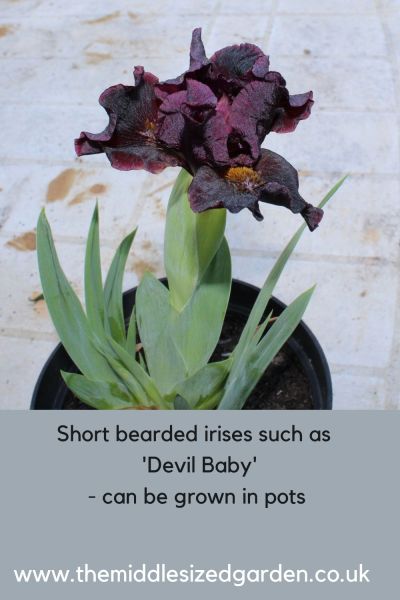
What problems do irises have?
Irises are generally quite trouble free. The two main diseases you really have to watch out for in irises, says Sue is leaf spot and rhizome rot.
Leaf spot is a fungus like black spot on roses, cut the leaf off and dispose of it, and if you use anti-fungal sprays then use one. With rhizome rot, dig up and divide the iris, disposing of any rotten or shrivelled root, or you can often even cut the rotted bit out.
Why is my iris not flowering?
The number one answer to this question is that the iris root is not getting enough sun, says Sue. Even if it has flowered in earlier years, something may have grown and started shading it.
For example, I’ve been growing a beautiful iris Folie Douce. I planted it on a sunny corner of a south facing bed and it’s been stunning. But I can see that this year there don’t seem to be any flowering stems.
But it’s planted next to a rose and that rose grew a lot last year. The rose foliage doesn’t appear to cover the iris rhizome, but looking at it in sunlight I can see that the foliage is indeed casting a shadow over the iris roots. I will either have to move the iris or cut back the rose in order to keep the flowering as good as it has been.
The number two reason why your iris isn’t flowering could be if you’ve been feeding it too much fertiliser. Don’t fertilise an iris too often or it’ll grow leaves at the expense of flowers, says Sue. Just add a small amount of fertiliser when you divide and replant but otherwise leave alone.
The number three reason for non-flowering is that your iris is overcrowded and needs to be lifted and divided.
And finally, if your iris has only recently be planted or replanted, then it may take time to establish. It may not flower this summer, but if it has enough sun on its rhizomes it may flower next.
But growing irises has its surprises…
I have a clump of beautiful pale pink irises (called Beverley Sills) which seem to be breaking the rules.
The rhizomes of Beverley Sills are swamped by a clump of vigorous Cerinthe major ‘Purpurescens’. Yet I can see flower stems on it.
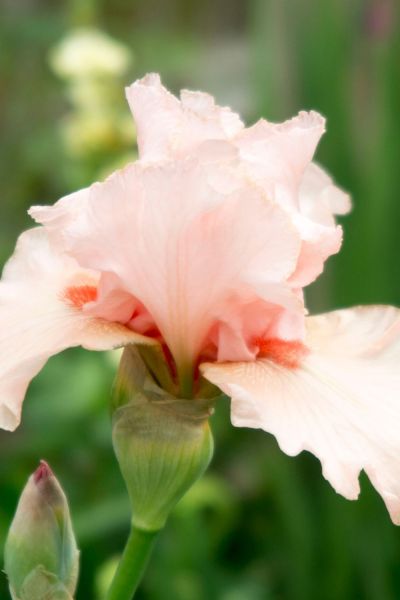
Iris ‘Beverley Sills’ has coped very well with the competition from the Cerinthe Major ‘Purpurescens. because as soon as the cerinthe is over, I clear it away so that the iris rhizome is expose to the sun.
It seems the key to this is that the cerinthe is an annual and it re-seeds itself. It emerges around January and February but by the time it’s swamped the iris roots, it’s ready to flower. It’ll flower for about 6 weeks from early April onwards. Then I’ll clear it away.
So the iris roots will be exposed to full sun from June and over the crucial summer months, so that is why I was getting away with apparently overcrowding my iris. And the rhizomes are also exposed for most of the winter, too.
Growing irises video
The video version of ‘Growing irises’ has more irises to look at, especially those growing over-looking some beautiful views at Doddington Place Gardens in Kent.
More about Iris of Sissinghurst
Iris of Sissinghurst are based in Kent, South East England. They only sell irises – by mail order, at shows and to garden designers.
But there are a number of ‘open weekends’ a year, timed to coincide with when different irises flower. Customers can visit, see the irises in bloom and buy. These are currently closed due to Covid 19, but consult the website for re-opening times.
For the RHS Chelsea Flower Show, they usually link up with the French company, Cayeux Iris, one of the largest iris growers in the world. Together they’ve won several silver, silver-gilt and gold medals for their displays.
Shop my favourite gardening books, products and tools
I’m often asked for recommendations so I’ve put together lists on the Middlesized Garden Amazon store. They include, for example, a list of Essential Garden stuff, such as kneelers and pots, featuring the brands I’ve found good. Note that links to Amazon are affiliate, which means I may get a small fee if you buy through them, but it won’t affect the price you pay. And I only recommend products I use myself.
Pin to remember growing irises tips
And do join us on Sunday mornings for tips, ideas and inspiration for your garden.

























What is chopping off the top of my irises but not eating them? The blooms are all on the ground.
Could it be deer? In which case higher fencing is the answer, unfortunately.
Do the leaves on a newly planted iris droop some? Iris are a new experience for me.
I don’t think leaves on an iris should droop, have you given it water?
Are irises poisonous to humans if we touch the inner bulb?? Also I have touch my iris and it seems like there sensitive to touch because they close up on me is this normal? I was astound broth this.
I’ve never had any trouble touching irises myself, but I understand they can cause some skin irritation in some people. If you’re affected, you could use gloves when handling them. I haven’t had the experience of them closing up when touched, that’s interesting.
I’m pretty new to gardening and I’ve planted Mission Bay irises but alas they are overshadowed and not growing very well. It’s may here in england – could i dig up them up now and move them or should i wait? Thank you
It’s usually considered better to wait until any time between August and November, although I’m always a fan of giving something a go and seeing what happens.
I bought several different colors of Iris plants, but over the years, all the colors died out or did not bloom, except the yellow ones. What is the cause?
Are they in a sunny enough spot? They need to have sun on their rhizomes. Sometimes you might think that a south facing border is sunny, but it may be shaded more than you realise by a building, fence or even other plants. Irises also need dividing every few years, when you discard the old rhizomes and replant the new ones. I hope that helps.
We divided our beautiful but crowded Iris last year and although the leafy growth is healthy we havnt had any flowers this summer? Is this normal and should we perserver and be patient for next years growth ?
I have found this too – I’d suggest making sure that the rhizomes get good sun, and adding some fertiliser, then I hope you’ll be rewarded next year. I think it can take a year for the plant to re-adjust.
Can you recommend the best compost for irises planted in containers?
I’ve had a look around and can’t find much information on the subject, so I’d suggest an all-purpose potting compost and adding some grit for drainage. That’s not a very expert reply, I’m sorry, but I hope it helps.
Can irises grow in a raised garden bed?
There shouldn’t be any problem – in fact, it could be easier to get that all-important sun on their rhizomes.
Californians can grow the native wild iris, Iris douglasiana. Not over-bred, they are found along our coast from Oregon down to about Point Reyes. These natives prefer part or full shade and richer soils and they are often fast-growing. Almost always purple. You can read about them at https://calscape.org/Iris-douglasiana-(Douglas-Iris)?srchcr=sc5ec153d4a925d
There is also a hybridized set of I. douglasiana, called Pacific Coast Natives – often referred to as PCNs – here is a link to their society: https://www.pacificcoastiris.org/gardeniris_growing_tips.html
Interesting, thank you.